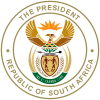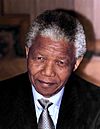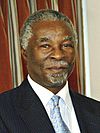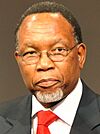President of South Africa facts for kids
Quick facts for kids President of theRepublic of South Africa |
|
|---|---|

Presidential seal
|
|
| Government of South Africa | |
| Style | Mr. President (informal) His Excellency (formal, diplomatic) |
| Member of | Cabinet |
| Residence | Mahlamba Ndlopfu (Pretoria) Genadendal (Cape Town) Dr. John L. Dube House (Durban) |
| Seat | Union Buildings |
| Appointer | National Assembly of South Africa |
| Term length | Five years,
renewable once
|
| Constituting instrument | Constitution of South Africa (1996) |
| Precursor | State President |
| Formation | 10 May 1994 |
| First holder | Nelson Mandela |
| Deputy | Deputy President |
| Salary | R 3,900,000 annually (2019) |
The President of South Africa is the country's top leader. This person is both the head of state (the symbolic leader of the country) and the head of government (the person who runs the government). The President leads the government's executive branch and is also the commander-in-chief of the South African National Defence Force, which means they are in charge of the country's armed forces. Before 1994, the main leader was called the State President.
The National Assembly, which is part of the Parliament, chooses the President. Usually, the President is the leader of the political party that wins the most votes in the general election. Since the first election where all races could vote on 27 April 1994, the African National Congress has been this party. The country's Constitution says that a President can serve for two terms, with each term lasting five years. Nelson Mandela was the first President elected under this new system. The current President is Cyril Ramaphosa, who was chosen by the National Assembly on 15 February 2018. This happened after Jacob Zuma resigned from the position.
Under an earlier version of the Constitution (from 1994 to 1996), there was a special "Government of National Unity." In this system, a member of Parliament from the second-largest party could also become a deputy president. For example, F. W. de Klerk, who was the last president during the apartheid era, served as a deputy president alongside Thabo Mbeki. De Klerk was the leader of the National Party, which was the second-largest party at the time. However, he later left this role. Even though the system changed in 1996, governments can still choose to work together, but opposition politicians have not been appointed as deputy president since then.
To become President, a person must be a member of the National Assembly when they are elected. Once elected, they give up their seat in the Assembly for their time as President. A President can be removed from office if Parliament passes a motion of no-confidence or through an impeachment trial.
Contents
How the Presidency Started
The idea of a top leader in South Africa has changed over time. In the past, British colonies like Natal and the Cape of Good Hope were led by governors. The Boer republics, like the Transvaal and the Orange Free State, had their own presidents. After several wars, including the South African War, the Treaty of Vereeniging was signed.
On 31 May 1910, the Union of South Africa was formed. It was part of the British Empire, and the British monarch was the head of state. A governor-general represented the monarch in South Africa.
After a vote in 1960, South Africa became a republic on 31 May 1961. This led to the creation of the State President role. At first, this was mostly a ceremonial job. But in 1984, a new constitution made the State President the main executive leader, taking over the powers of the Prime Minister. In 1994, South Africa ended minority rule, and the current office of the President was created by Chapter Five of the Constitution of South Africa.
How the President is Chosen
South Africa has a special way of choosing its President. Unlike many other countries that used to be British colonies, South Africa's President is both the head of state and the head of government. They are also the commander-in-chief of the South African National Defence Force (SANDF). Instead of being elected directly by the people, the President is chosen by the Parliament of South Africa. This means the President is responsible to Parliament and can influence laws because they lead the majority party.
The President is elected during the first meeting of Parliament after a general election, or whenever the position becomes empty. The election happens in the National Assembly, and the chief justice oversees it. Once elected, the person stops being a member of the National Assembly. They must then be sworn in as President within five days. If the position becomes empty, the chief justice sets a date for a new election, which must happen within 30 days.
This system combines parts of both parliamentary and presidential systems in a unique way. Only a few other countries, like Botswana, use a similar method. The President's term is five years, and they can serve a maximum of two terms. This system aims to prevent too much power from building up in one person, which was a problem during the Apartheid era.
Who Takes Over if the President Can't Serve?
According to Chapter Five of the Constitution, the President can only use their powers when they are inside South Africa. If the President travels outside the country or cannot do their job, they can choose an acting president.
If the President's position becomes completely empty, the deputy president takes over first. If the deputy president cannot, then a Cabinet minister chosen by the President takes over. If that's not possible, a Cabinet minister chosen by the Cabinet steps in. Finally, if none of those options work, the Speaker of the National Assembly would become the acting president.
What Powers Does the President Have?
The President is the head of state, the head of government, and the commander-in-chief of the South African National Defence Force. The President's duties, powers, and salary are explained in Chapter V of the Constitution of South Africa and other laws.
The President has the power to run the country's executive branch. They appoint many important officials, including the Cabinet ministers and judges for the Supreme Court of Appeal and the Constitutional Court. The Cabinet helps the President carry out the laws and achieve their goals. Judges are appointed based on advice from the Judicial Service Commission.
The President also helps create laws. They can sign bills into law or reject them (though Parliament can sometimes overrule this). They can send bills back to Parliament or to the Constitutional Court for review, or even call for a public vote (referendum). The President calls Parliament together and often gives a "State of the Nation Address" at the start of each new session.
As commander-in-chief of the armed forces, the President has a big say in foreign policy and national security. The Constitution gives the President the power to declare war and make peace, negotiate and sign international agreements, and welcome or appoint diplomats. They also give out awards and can grant pardons.
Presidents of South Africa Since 1994
- Parties
African National Congress
| No. | Portrait | Name (Birth–Death) |
Elected | Term of office | Parliament | Political party | Government | Refs | ||
|---|---|---|---|---|---|---|---|---|---|---|
| Took office | Left office | Time in office | ||||||||
| 1 |  |
Nelson Mandela (1918–2013) |
1994 | 10 May 1994 |
14 June 1999 |
5 years, 35 days | 22nd | ANC | Mandela (Reshuffle 1 · 2 · 3) ANC—NP—IFP |
|
| Nelson Mandela was the first President of South Africa after the end of apartheid. He was the first black leader of the country and the first to be chosen in a truly democratic election where everyone could vote. His government worked to undo the unfairness of apartheid, focusing on fighting racism, poverty, and inequality. He also worked to bring different groups of people together. He was the President of the African National Congress (ANC) party from 1991 to 1997. | ||||||||||
| 2 |  |
Thabo Mbeki (born 1942) |
1999 2004 |
14 June 1999 |
21 May 2004 |
9 years, 102 days | 23rd | ANC | Mbeki I ANC—IFP |
|
| 21 May 2004 |
24 September 2008 |
24th | Mbeki II (Reshuffle 1 · 2) |
|||||||
| Thabo Mbeki was the second President after apartheid. He resigned on 20 September 2008, with about nine months left in his second term. This happened after the National Executive Committee of the ANC asked him to step down due to concerns about his leadership. | ||||||||||
| 3 |  |
Kgalema Motlanthe (born 1949) |
2008 | 25 September 2008 |
9 May 2009 |
228 days | 24th | ANC | Motlanthe | |
| Kgalema Motlanthe was the third President after apartheid. He was elected after Thabo Mbeki resigned and served for a short time. Later, Jacob Zuma appointed him as deputy president. | ||||||||||
| 4 |  |
Jacob Zuma (born 1942) |
2009 2014 |
9 May 2009 |
24 May 2014 |
8 years, 281 days | 25th | ANC | Zuma I (Reshuffle 1 · 2 · 3) |
|
| 24 May 2014 |
14 February 2018 |
26th | Zuma II (Reshuffle 1 · 2 · 3) |
|||||||
| Jacob Zuma was the fourth President after apartheid. He led the country during the 100th celebration of the ANC in 2015 and during the passing of Nelson Mandela in 2013. He resigned on 14 February 2018, less than a year before his term was supposed to end. This happened after the ANC asked him to resign. | ||||||||||
| 5 |  |
Cyril Ramaphosa (born 1952) |
2019 2024 |
15 February 2018 |
22 May 2019 |
7 years, 330 days | 26th | ANC | Ramaphosa I | |
| 22 May 2019 |
14 June 2024 |
27th | Ramaphosa II | |||||||
| 14 June 2024 |
Incumbent | 28th | Ramaphosa III ANC—DA—IFP—PA |
|||||||
| Cyril Ramaphosa is the fifth President of South Africa since apartheid ended. He was elected after Jacob Zuma resigned. | ||||||||||
Timeline of Presidents

Latest Election Information
Related Topics
- List of heads of state of South Africa
- State President of South Africa
- Prime Minister of South Africa
- Governor-General of South Africa
- Deputy President of South Africa
- State President of the South African Republic (1857–1902)
- State President of the Orange Free State
- Freedom Day
- List of South African presidents by age
See also
 In Spanish: Presidente de Sudáfrica para niños
In Spanish: Presidente de Sudáfrica para niños


